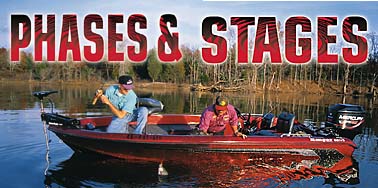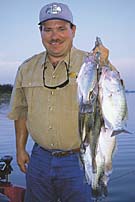|

By Reavis Z. Wortham
page 2
Variances in temperature and weather conditions
dictate where fish will and won't be. Northers in the spring are
common as armadillos upside down on the highway (Report: Armadillos
are not born dead on the side of the road. I actually saw one
alive - just before it ran in front of the truck.) and play havoc
with both black and white crappie patterns, driving them back
into deeper water to wait out the cold snap. They usually won't
go into the deepest part of the lake, but the fish will find a
comfortable layer in their earlier staging areas.
During stable weather, when the fish are shallow
in the creeks, the technique is simple. Locate laydowns, or any
structure in the creek - the thicker the better - and with a long
pole with plenty of backbone and heavy line, lower the bait in
the thickest, nastiest part of the brush. The best way to determine
good crappie cover in these areas is the following rule of thumb:
If you need a chainsaw to get through the limbs and into the water,
you'll have more action than you can stand. They can be hanging
around in less than 18 inches, looking for love and a quick meal.
 One exceptional location for spring crappie through
April and May is shallow flooded grassy areas. Fishing the flats
is one of the most productive techniques. These open-water flats
are where the males prepare the nests for the females, who stay
away shopping and doing their hair until the water reaches the
mid-60s. The males stake out their territory in the shallowest
water possible, preferring to make their nests on fine gravel.
If that's unavailable, they'll settle for sand. One exceptional location for spring crappie through
April and May is shallow flooded grassy areas. Fishing the flats
is one of the most productive techniques. These open-water flats
are where the males prepare the nests for the females, who stay
away shopping and doing their hair until the water reaches the
mid-60s. The males stake out their territory in the shallowest
water possible, preferring to make their nests on fine gravel.
If that's unavailable, they'll settle for sand.
Wade fishing the flats is an exciting change of
pace for the adventurous angler. Marshall likes it because, "it
puts me eyeball-to-eyeball with them." A good set of neoprene
waders is a must for this time of the year, for 65 degrees might
sound warm there in your living room - or that little tiled throneroom
where we do most of our reading - but it's chilly to hairy-legged
boys like me. Careful wading and probing, a slower kind of fishing,
is always productive.
A long rod with a cork holding the bait a foot
or so below is dabbled into likely-looking holes in the grass
or vegetation. Minnows are deadly in this environment. The aggressive
males will hit with surprising ferocity, and the fight can be
considerable. Anglers again look for structure, but here it can
be as tiny as a single twig protruding through the surface of
the water. Wade fishermen can thoroughly work likely-looking cover
with this equipment with a minimum of effort.
Marshall cautions first-timers about this method.
"Anglers need to be familiar with the water and move cautiously.
Deep holes are deadly to fishermen in waders." His favorite
jig in this case is a 1/16-ounce Blakemore blue and white turbo
tail.
Experts say another consideration is the phases
of the moon. A full moon results in heavy nighttime spawn - you
know how those kids are in the dark. Anglers who venture into
this entirely different netherworld of crappie fishing will delight
in large numbers of slabs on the stringer in no time. However,
the downside is slow daylight fishing during this phase. Those
who can wait until the dark of the moon will usually boat more
fish in the daytime.
Springtime means wind, and experienced anglers know
that a north wind will drive the slabs into the northernmost bank
where the water is calmer. If the wind hasn't dropped the temperature
too drastically, you can still find the fish suspended against
traditional structure such as drowned trees and stumps near the
mouths of creek channels, and in the feeder creeks themselves.
By the end of April the spawn is over in most Texas
lakes. The fish begin to move back into deeper water as they head
for the traditional structure holding both fish and anglers.
Crappie can be anywhere once the spawn is over,
seeking water temperature which suits them. They move at will,
sometimes where you expect them, such as around bridge pilings
or docks, and other times suspended 5 to 15 feet around inundated
trees and submerged brushpiles. Any quality depthfinder will locate
these fish magnets where thick wads of fish avoid the noonday
sun.
At this stage of the game in May use the marked
brushpiles on the state's newer lakes, where they're clearly marked
on lake maps and easily located by buoys. If you catch a few crappie
from one spot and the action slows, move somewhere else - but
don't hesitate to come back later. The odds are the fish will
move back once the disturbance is over.
Marshall doesn't waste much time at any one
location when he's fishing, no matter what the phase. "The
key is to jig a likely-looking spot for a minute or two. If you
get only one or two bites, or none at all, move to another location
until you hit a big concentration of fish. Then get the skillet
hot."
Stay on top of the changes in weather patterns
and the variations in water temperature. With these few tips in
mind, you can have a fish fry in the making each time you hit
the water.
"Hey Wally, how does that Palomar knot go
again??? ... never mind, grannies have worked for years."
# # # #
page 1 / page 2
| 




